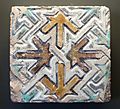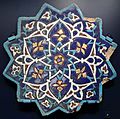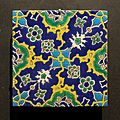Cuerda seca facts for kids

Cuerda seca (say "KWER-dah SEH-kah") is a Spanish phrase meaning "dry cord." It's a special way to decorate pottery and tiles with different colored glazes. This technique helps keep the colors from mixing together when the pottery is heated in a kiln.
What is Cuerda Seca?
When artists put different colored glazes on pottery, the colors can sometimes run into each other when baked in a hot oven called a kiln. This makes the design messy.
To stop this, the cuerda seca method uses thin lines of a greasy material. These lines act like tiny fences, keeping each color in its own spot. A dark color, like a special kind of manganese, is often mixed with the grease. This creates a dark outline around each colored area, making the design stand out.
History of Cuerda Seca
Many experts believe the cuerda seca technique first appeared in al-Andalus. This was the name for parts of Spain and Portugal ruled by Islamic people. It started around the late 900s, during the time of the Caliphate of Córdoba. The technique became even better in the 1000s.
Some of the oldest examples of cuerda seca tiles used in buildings are from the late 1100s. These were found on the minaret of the Kasbah Mosque in Marrakesh, Morocco.
In central Asia, artists began using cuerda seca from the mid-1300s. You can see examples in the mausoleums of the Shah-i-Zinda necropolis in Samarkand. At first, they used only white, turquoise, and cobalt blue. But by 1386, they added yellow, light-green, and even unglazed red. Lots of cuerda seca tiles were made during the Timurid dynasty (1370–1507) and Safavid dynasty (1501–1736) periods.
In the 1400s, potters from Tabriz in Persia brought this technique to Turkey. They used it to decorate the Yeşil Mosque in Bursa between 1419 and 1424. However, in the Ottoman Empire, cuerda seca became less popular by the 1550s. New buildings started using different types of decorated tiles from İznik. The last building in Istanbul to feature cuerda seca tiles was the Kara Ahmed Pasha Mosque, which was finished in 1572.
Gallery
-
Cuerda seca tile from the Alcazar of Seville, 12th-13th century
-
Tiles in the Green Mosque, Bursa, around 1420
-
Dish from Seville in Spain, early 16th century
See also
 In Spanish: Cerámica de cuerda seca para niños
In Spanish: Cerámica de cuerda seca para niños








